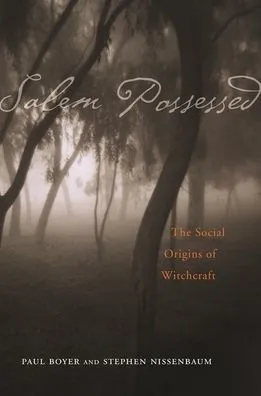I’ve been doing a lot of reading recently on occult beliefs in colonial New England, something that ordinarily does not interest me all that much, but I acquired a few books, and I was thinking about the Salem witch persecutions and what may have led up to them. Among the prizes is an older book: Salem Possessed by Paul Boyer and Stephen Nissenbaum.
It is a social history of Salem Village and the various factors that led up to the witch persecutions there in 1692. it is quite fascinating – Salem was a community that was divided in a lot of different ways and the witch persecutions followed the lines of division that already existed in the community between basically a more conservative and rural faction and the more mercantile and urban oriented faction of the community. The people who were accused of witchcraft and convicted were, in virtually all cases, connected to the more reform-oriented group of the community, and those that accused them came from the more rural and agrarian oriented faction of the village.
There were many factors involved which Boyer and Nissenbaum go into in detail. What’s particularly interesting about this book is not just that it is an excellent local history but also that it is based very strongly on documentary evidence, and not only the usual documentary evidence – they go into the court cases, of course, but also a very deep dive into primary documents, examining collections of sermons, memoirs, tax records, inheritance and land titles, and other court cases involving both the accusers and accused. They paint an interesting and detailed portrait of what was going on in the community and how distrust and division exploded into these witchcraft accusations and trials.
One key insight that is frequently forgotten is that the Salem events were the tail-end of witch hunts and rather than the hunters being “a dominant and ruthless group that had taken offense against a set of weak and powerless outcasts”, they were already in retreat at that point, the Puritan hegemony collapsing, and they would soon be defeated. (xiii). “The overall direction of the accusations remains clear: up the social ladder… whatever else they may have been, the Salem witch trials cannot be written off as a communal effort to purge the poor, the deviant, or the outcast.” (33) And it was the ministers, among the most influential people in the colonies, who pushed to end the persecutions after six months. (9-11)
Boyer and Nissenbaum also edited a good collection of primary documents concerning Salem; Salem-Village Witchcraft, a Documentary Record of Local Conflict in Colonial New England (1972, reprinted Northwest University Press, 1993) that is very useful to students of the era.
~review by Samuel Wagar
Authors: Paul Boyer and Stephen Nissenbaum
Harvard University Press, 1974
231 pg. Paperback £25 / $41 Can / $31.50 US

